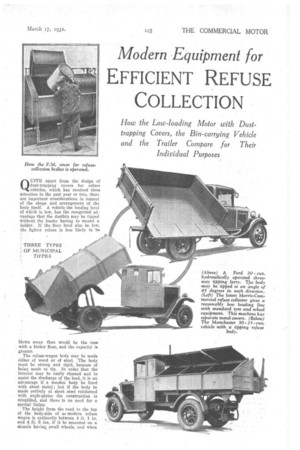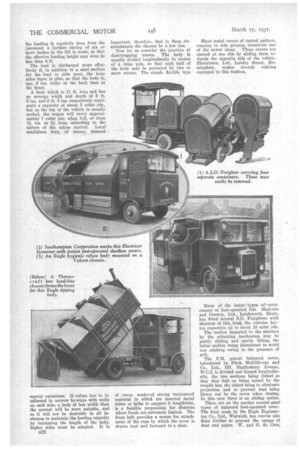Modern Equipment for
Page 89

Page 90

Page 91

If you've noticed an error in this article please click here to report it so we can fix it.
EFFICIENT REFUSE COLLECTION
Q'LUTE apart from the design . of dust-trapping covers for refuse . vehicles, which has received close attention in the past year or two, there are important considerations in respect of the shape and arrangement of the body itself. ' A vehicle the loading level Of whiz-fh is low, has the recognized adVantage that the dustbin may be tipped Without the loader having to mount a ladder, if the floor level also be low, the lighter refuse is less likely to be
blown away than would be ilte ease with a hicher floor, and the capacity is greater.
The refuse-wagon body may be made either of wood or of steel. The body must be strong and rigid, because of being made to tip. In order that the Interior may be easily cleaned and to assist the discharge of the load, it is an advantage if a wooden body be lined with sheet metal; but if the body be made entirely of sheet steel reinforced with angle-plates the construction is simplified, and there is no need for a special 'lining.
, The height from the road to the top of the body-side of a, modern refuse wagon is ordinarily between 4 it. I ill. and 4.ft. 6 ins, if it be Mounted on a ahassis having small wheels, and when
the loading is regularly done from the pavement a further saving of six or more inches in the lift is made, so that the effective loading height may even be less than 4 ft.
The load is discharged more effectively if, in addition to a steel surface for the load to slide upon, the body sides taper in plan, so that the body is, say, 6 ins, wider at the back than at the front.
A body which is 11 ft. long and has an average width and depth of 5 ft. 6 ins. and 2 ft. 3 ins, respectively represents a capacity of about 5 cubic yds., but as the top of the vehicle is usually arched, the wagon will carry approximately 7 cubic yds. when full, or from 11 ton to 21 tons, according to the nature of the refuse carried. Local conditions May, of • course, demand
special variations. If refuse has to be collected in narrow by-ways with walls on each side, a body of less width than the normal will be more suitable, and as it will not be desirable in all instances to maintain the loading capacity by increasing the length of the body, higher sides must be adopted. It is D28 important, therefore, that in these circumstances the chassis be a low one.
Now let us consider the question of dust-trapping covers. The body is usually divided longitudinally by means of a ridge pole, so that each half of the body may be protected by two or more covers. The simple flexible type of , cover, made-rof strong waterproof material in which are inserted metal tubes or laths to support it lengthwise, Is a feasible proposition for districts where funds are extremely limited. The front lath provides a means for attachment of the rope by which the cover is drawn taut and fastened to a cleat. Sheet metal covers of curved patteru,. running in side grooves, constitute cum of the newer ideas. These covers are opened at one side by sliding them towards the opposite side of the vehicle. Electricars, Ltd., Lawley Street, Birmingham, makes electric vehicles equipped in this fashion.
Many of the latest 4types 'of' covei consist of foot-operated lids. Shelvoke and Drewry, Ltd., Letchworth, Herts, has fitted several S.D. Freighters with shutters of this, kind, the vehicles baying capacities up to about 10 cubic yds.
Tho motion imparted to the shutters by the actuating mechanism may be partly sliding and partly lifting, the latter motion being introduced to avoid any sticking owing to the presence of grit The F.M. patent balanced cover, introduced by Fitch, McGillivray and Co., Ltd., 167, Shaftesbury Avenue, W.C.2, is divided and hinged longitudinally, the two sections being linked so that they fold on being raised by the treadle bar, the object being to eliminate projection and to prevent dust being blown out by the cover when closing. In this case there is no sliding action.
There are on the market several good types of balanced foot-operated cover. The kind made by the Eagle Engineering Co., Ltd., Warwick, has canvas side flaps further to prevent the escape of dust and paper. W. and G. du Cros, Ltd., Acton, London, W.3, has turned out some sound all-metal bodies with balanced metal covers, and the Vulcan OK-type vehicle has attained some success. The General Vehicle Co., Ltd., 15 Devonshire Street, London, E.C.2, has produced a large-capacity sixwheeler with high vertical sides incorporating sliding doors, carried on rollers at the top and bottom, which may be adjusted to give openings at the heights desired for load distribution.
The idea advanced by Tuke and Bell, Ltd., Lichfield, Staffs, is worthy of attention. The operator ascends two ISteps at the rear and enters the vehicle, shooting the bin contents, over a partition into the fore part of the vehicle. The partition ie moved aft as the load increases, and a canvas shutter is drawn out to cover the refuse already loaded. The same concern makes a quick-acting hand or foot-operated cover.
A highly advanced method of refuse collection is obtained with the New Eagle body, which is cylindrical and may be rotated for trimming the load, loading being effected by special doors which fit exactly the Em-em bins that are required.
An excellent way of collecting refuse of any kind is not to empty each bin into a wagon, but to collect the loaded bin, substituting a cleaned and empty one for use until the next call of the wagon. This method is being used by Westminster City Council, and may be more generally adopted in the future for the house-to-house collection of refuse, if hquseholders can be persuaded not to overfill their dustbins, in order to ensure' the proper fitting of the dustbin lids. The Eagle Engineering Co., Ltd.. of Warwick, has produced a trailer for the conveyance of 88 loaded bins.
The container system is used considerably for the collection .of refuse from. hotels, institutions, flats, etc., where a large-quantity of refuse accumulates in a few days. The containers can be-carried on a platform, which is mounted directly 4fn the chassis. They have' castors or wheels on the under
side, so that they can be rolled sideways off the platform. For discharging, each container may have its own tipping gear. Some chassis are equipped for four containers. Each may be rolled sideways off the platform, or they may he tipped in pairs. While the container is in use it is mounted on a stand of the same height as the refuse-wagon platform. The stands must be in duplicate, so that an empty bin may be transferred from the wagon before the filled container is moved. In some instances it may speed up collection if, instead of using containers, the whole of the body can be rolled off at the rear and left to be filled, the motor chassis then taking away a body which has been loaded in anticipation of_its call.
Refuse collection is also done by means of two and four-wheeled trailers, those of Eagle make being prominent in this respect. A low loading line is obtained by mounting the trailer on small
wheels, by cranking the trailer frame, or by building the body between the wheels, The trailer has the advantage that it can be loaded and unloaded independently of the tractor, and, as it has its own wheels, the uncoupling of one trailer from the tractor, and the attachment of another can be done in a minimum of time. Even when the trailer is nominally only a two-wheeler it is often provided with a front castor or jockey wheel. The trailer may be tipped either by hand or by power, and a very wide scope is available in the design arid size of the bodywork.
For narrow roads and alleys Karrier
























































































































































































